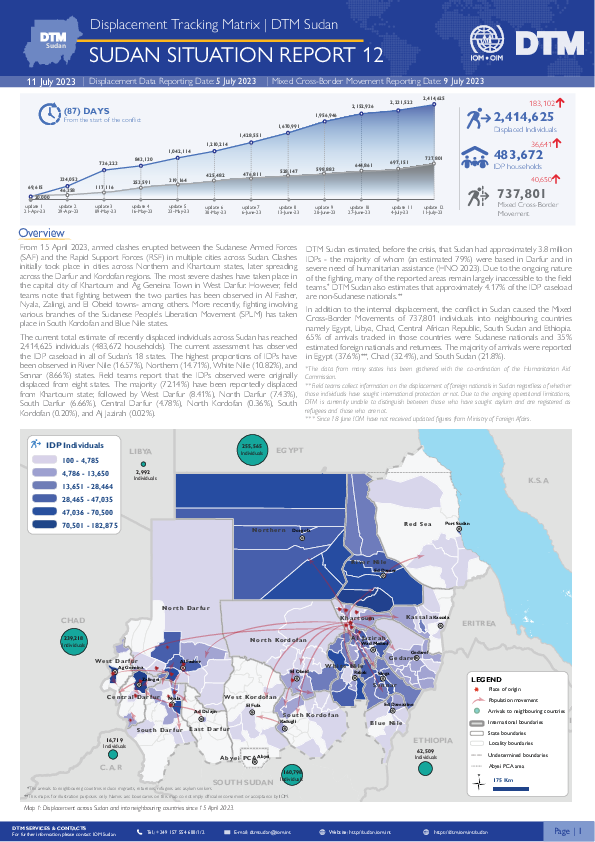-
Countries
-
Data and Analysis
-
Special Focus
-
Crisis Responses
DTM Sudan - Situation Report (12)

Contacto
DTM Sudan; dtmsudan@iom.int
Idioma
English
Ubicación
Sudan
Snapshot Date
Jul 05 2023
Actividad
- Mobility Tracking
- Baseline Assessment
From 15 April 2023, armed clashes erupted between the Sudanese Armed Forces (SAF) and the Rapid Support Forces (RSF) in multiple cities across Sudan, including Khartoum, Al Fasher, Kebkabiya, Merowe, Nyala, Zalingi, Ag Geneina, and El Obeid. DTM Sudan has been receiving reports of widespread displacement across different states in Sudan due to the ongoing security situation.
- DTM Sudan estimates that, since 15 April 2023, approximately 2,414,625 individuals (483,672 households) have been displaced internally as a result of the conflict. Notably, the current estimate for displacement in the previous 87 days is greater than that of recorded displacement during the previous four years.
- Furthermore, an estimated additional 737,801 individuals have crossed into neighbouring countries.
Due to the ongoing nature of the fighting, many areas reportedly remain inaccessible to field teams. DTM estimates of displacement are based on preliminary reports from field teams and should be taken as estimations only. Additional reports of displacement are likely to emerge as the situation becomes clearer.
The IDP caseload has sought shelter in locations across all of Sudan’s 18 states. IDPs have been originally displaced from eight states, including Khartoum, West Darfur, South Darfur, North Darfur, Central Darfur, North Kordofan, South Kordofan, and Aj Jazirah.
Disclaimer: DTM Sudan notes that military clashes remain continuous in many areas across Sudan in particular in Khartoum and the Darfur region – limiting humanitarian access. Additionally, field teams have reported severe telecommunication and connectivity issues, as well as escalating economic pressures which have impacted the capacity for domestic travel. As such, DTM is currently conducting remote interviews with key informants across its network and is currently unable to engage in the additional verification of these figures. Data on flows into neighbouring countries is based on available information from DTM flow monitoring networks and secondary sources.
